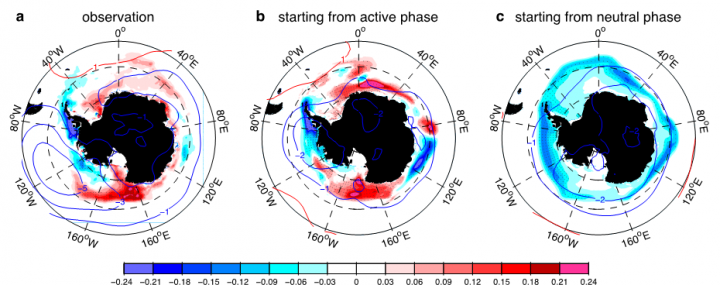December 3rd, 2018
Key Findings
- Observations show an expansion of sea ice and cooling sea surface temperatures (SST) in the Southern Ocean over the last several decades. In contrast, CMIP5 models simulate a steady warming and reduction of Antarctic sea ice.
- There is substantial natural multidecadal-to-centennial variability in the Southern Ocean in a new climate model, GFDL SPEAR_AM2. This natural variability can produce ~30-year trends in SST and sea ice concentration resembling recent observations
- This natural variability, superimposed on the response to anthropogenic forcing, can reproduce the observed trends when the model starts from a particular phase of this variability in the 1970s (similar to what was observed). In contrast, simulations starting from a neutral phase do not reproduce the observed changes, but instead are similar to the results from the CMIP5 ensemble.
- These results suggest that the observed changes in the Southern Ocean are consistent with a strong role for natural multidecadal variability. As a corollary, the opposite phase of this variability could lead to accelerated warming and sea ice loss over coming decades.
Liping Zhang, Thomas L. Delworth, William Cooke and Xiaosong Yang. Nature Climate Change. DOI: 10.1038/s41558-018-0350-3
Observations show that Arctic sea ice is rapidly declining, but observations also clearly show an expansion of Southern Ocean (SO) sea ice extent during the satellite era (1979 to the present). This modest increase is consistent with an observed SO cooling trend. The sea surface temperature (SST) and sea ice concentration (SIC) trends are not homogeneous in space, with opposing signs in the Amundsen-Bellingshausen Seas versus the Ross and Weddell Seas. In contrast, Coupled Model Intercomparison Project Phase 5 (CMIP5) models simulate a steady warming and reduction of Antarctic sea ice.
This study examines the possibility that internal variability involving deep ocean convection in the Southern Ocean could be a major contributor to the observed trends, likely in concert with other previously identified factors. The authors find that the natural multidecadal variability of SO deep convection could modulate the transient climate response to anthropogenic forcings, and that weakening of SO deep convection is a potential driver for the observed SST and sea ice trends over the SO. As a corollary, the opposite phase of this variability could lead to accelerated surface warming and loss of SO sea ice in the coming decades.
Several mechanisms have been proposed to explain the observed opposing trends. One proposed explanation involves surface wind changes driven by a number of factors, including (a) a positive trend of the Southern Hemisphere westerly winds in response to stratospheric ozone depletion, or (b) a deepened Amundsen Sea Low driven by remote tropical Pacific or North Atlantic SST anomalies. Another proposed explanation involves surface freshening caused by anthropogenic warming, possibly via global water cycle amplification and/or the melting of Antarctic glaciers and ice sheets.
For this study, the authors used simulations from a newly developed coupled ocean atmosphere model (SPEAR_AM2). They found that these observed trends are consistent with a particular phase of the natural multidecadal variability of SO deep convection as derived from climate model simulations. Ensembles of climate change simulations were conducted starting from different phases of this variability. Simulations started from an active phase of SO convection, such as may have occurred in the 1970s, can reproduce the observed pattern of SST and sea ice trends, particularly during the warm season (Dec-May). In contrast, simulations initialized from an inactive phase of SO convection do not reproduce the observed changes and are similar to the results of most climate models used in the CMIP5 ensemble. These results suggest that the observed changes in the Southern Ocean are consistent with a strong role for natural multidecadal variability, superimposed on the response to anthropogenic forcing.
It is critical for NOAA to improve our scientific understanding of observed changes in the climate system. Such understanding can potentially lead to an improved ability to predict future changes. This study provides critical new understanding of the potential factors behind observed decadal trends in Antarctic sea ice and upper ocean conditions. Further, this research raises the possibility that such changes may be predictable on decadal scales, and we are currently working on developing modeling tools to be able to predict such future changes.



